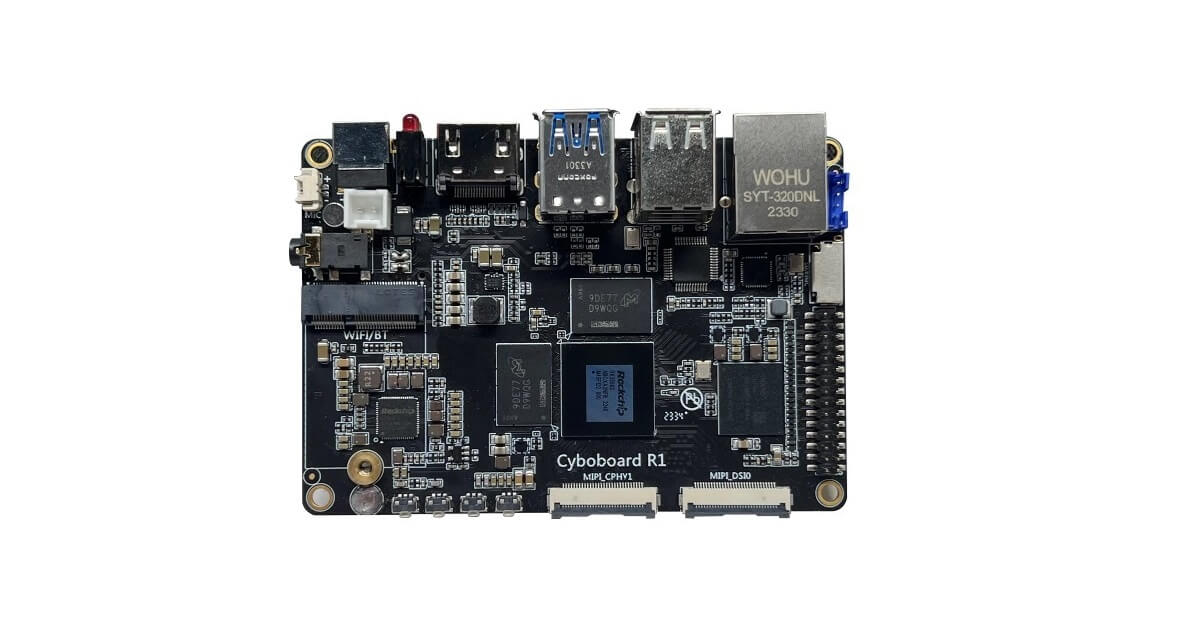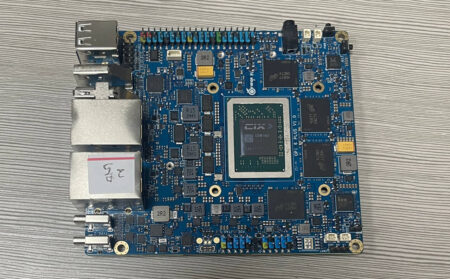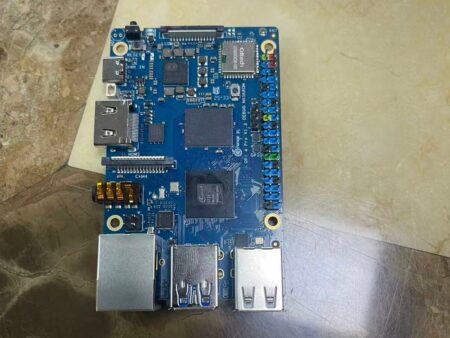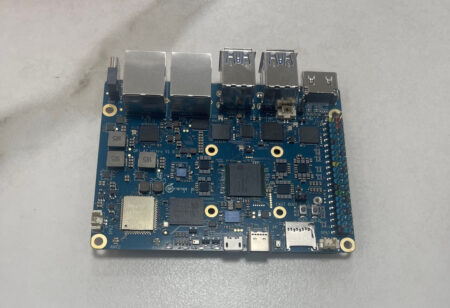- Did you perhaps overlook it? An in-depth analysis of the Youyeetoo X1.
- Youyeetoo R1 Review – Product information and price details.
Part I: Youyeetoo R1 SBC – Product Introduction
The youyeetoo R1 is a powerful Rockchip RK3588S SBC, featuring a wide range of capabilities within a compact 100×69.3 mm form factor. It includes two M.2 sockets for NVME/SSD or 4G LTE, as well as Wi-Fi and Bluetooth connectors. Additionally, it supports NFC, four display interfaces, two MIPI CSI camera interfaces and much more.
The board is equipped with the possibility of having up to 32GB of RAM and 256GB of eMMC flash storage. Additionally, it includes a high-speed gigabit Ethernet port, five USB interfaces for convenient connectivity, a built-in microphone, multiple audio inputs and outputs, and a versatile 30-pin header for expansion. Furthermore, it accommodates HDMI input through an adapter that can be connected to one of the MIPI CSI ports.
Interfaces

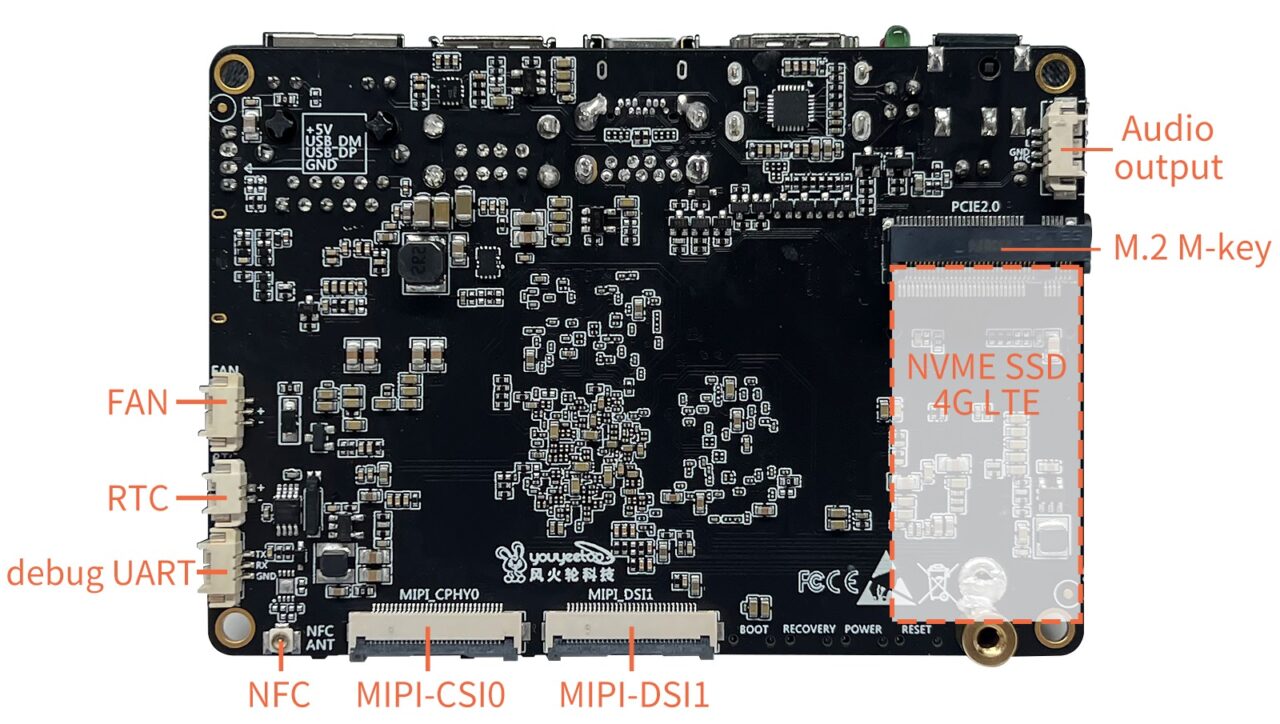
Youyeetoo R1 specifications
Youyeetoo R1 Hardware Specifications | |
Model | youyeetoo R1 |
Hardware features | |
SoC | Rockchip RK3588S |
Architecture | ARM |
TDP | 12W |
CPU | 8-core (64-bit) |
Total Threads | 8 |
Cores | • 4x Cortex-A76 cores @ up to 2.2-2.4 GHz • 4x Cortex-A55 cores @ up to 1.8 |
GPU | Arm Mali-G610 GPU with OpenGL ES 3.2, OpenCL 2.2, and Vulkan 1.2 support |
VPU | • 8Kp60 video decoder for • H.265/AVS2/VP9/H.264/AV1 codecs, 8Kp30 • H.265/H.264 video encoder |
NPU | 6 TOPS AI accelerator |
RAM & Storage Configurations | 4GB LPDDR4x /32GB eMMC |
Expansion | • 1x Micro SD (TF) Card Slot |
USB | • x2 USB-A socket: USB2.0 • x1 USB-A socket: USB3.0 • x2 4-pin header with USB 2.0 interface |
Display Input | • Camera I/F – 2x 4-lane MIPI CSI connectors |
Display output | • 1x HDMI 2.1 port up to 8Kp60 or 4Kp120 • 1x USB Type-C with DP1.4 support up to 8Kp30 |
On-board FAN socket | SH1.0 4PIN socket shipped with radiator as standard, 5V/0.2A power |
Audio Output | • x1 3.5mm audio jack (with mic) • x1 HDMI audio output • x1 SPK pin holder: Onboard 3W power amplifier. • x1 4-pin headerJ368: R/L/GND/MIC (header: SH1.25mm). |
Audio Input | • x1 Audio & Microphone 3.5mm audio jack. • x1 Microphone (On board) with noise reduction. |
Networking and connectivity | • NFC via external antenna (not included by default) • x1 Wireless: M.2(E-Key) Socket Expansion Slot |
NFC | Using the on-board external antenna, you can Data transfer with mobile phone, android / iOS support. |
GPIO | 30-pin GPIO header 3x I2C, 3x UART 1x CAN bus (CAN board needed) 1x PWM, 2x ADC 1x SPI 7x GPIO (3.3V or 1.8V), 5V, 3.3V, and GND power signals |
LED light | There are 2 red and blue LED lights on the board, connected in parallel with 4PIN pins for easy installation. The whole machine defaults to 3.3V (a tutorial API interface is provided to control on and off or heartbeat flashing). The default red light flashes and the green light is always off, and can be controlled programmably. |
Debug port | x2 4-pin UART TTL level serial port |
RTC | SH1.25 socket. It can be connected to an external button battery CR2032 to achieve power outage time and scheduled power-on. 3.3VRTC consumes about 35mAh per year. |
Buttons | Reset, Power. Recover, Boot |
PCB size | 100 x 69.3 mm |
On-board FAN Socket | 5V 3P ,1.25mm-SH1.25 Adjustable speed |
OS Support | ● Android 13(kernel 5.10) |
Weight | 67.8 grams |
Power | • 12V DC Input (5.5×2.1mm, 12V3A) |
Package Contents | youyeetoo R1 x1 (With Heat Sink) |
Astimate Price | Starting at $99 |
Youyeetoo offers extensive support for Android 13, Debian 11, Ubuntu 22.04, and Buildroot, all built upon the solid foundation of Linux 5.10. Although the wiki is a work in progress, it is continually improving to provide even more valuable information.
Initially, we were worried about the absence of cooling options and the absence of mounting holes for a heat sink or fan in this product. However, the company has intentions to launch a metal enclosure at a super low cost of $5.00.
NFC Support
It is likely the first Rockchip RK3588 or RK3588S board to have integrated NFC support. While the importance of this feature is uncertain, it is worth noting that a USB NFC reader can always be added. If NFC capability is a priority, the Youyeeto R1 could be a more cost-effective option, considering that USB NFC readers typically sell for $30 to $60 on Amazon, and the NFC antenna required by the Rockchip board costs only about $4.00.

